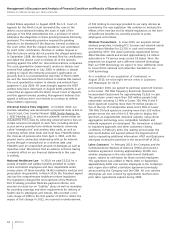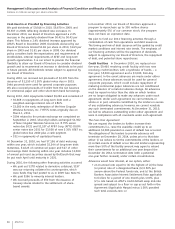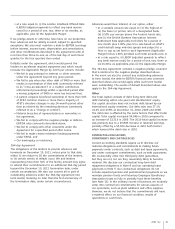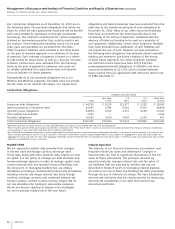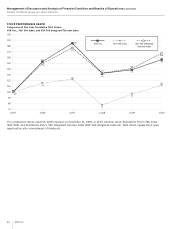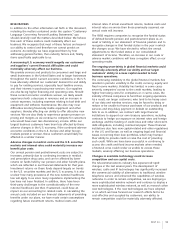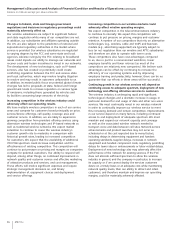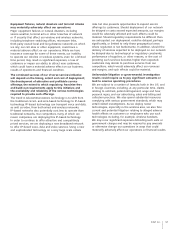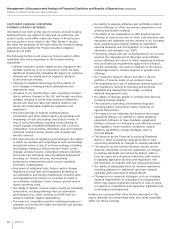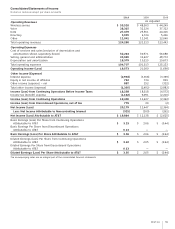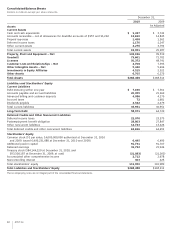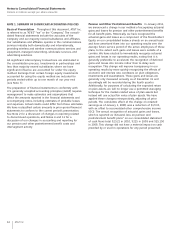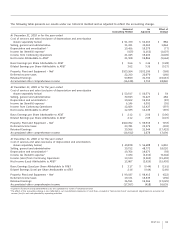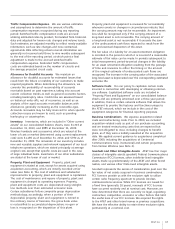AT&T Wireless 2010 Annual Report Download - page 59
Download and view the complete annual report
Please find page 59 of the 2010 AT&T Wireless annual report below. You can navigate through the pages in the report by either clicking on the pages listed below, or by using the keyword search tool below to find specific information within the annual report.
AT&T Inc. 57
risks but also presents opportunities to expand service
offerings to customers. Should deployment of our network
be delayed or costs exceed expected amounts, our margins
would be adversely affected and such effects could be
material. Should regulatory requirements be different than
we anticipated, our deployment could be delayed, perhaps
significantly, or limited to only those geographical areas
where regulation is not burdensome. In addition, should the
delivery of services expected to be deployed on our network
be delayed due to technological or regulatory constraints,
performance of suppliers, or other reasons, or the cost of
providing such services becomes higher than expected,
customers may decide to purchase services from our
competitors, which would adversely affect our revenues
and margins, and such effects could be material.
Unfavorable litigation or governmental investigation
results could require us to pay significant amounts or
lead to onerous operating procedures.
We are subject to a number of lawsuits both in the U.S. and
in foreign countries, including, at any particular time, claims
relating to antitrust, patent infringement, wage and hour,
personal injury, and our advertising, sales and billing and
collection practices. We also spend substantial resources
complying with various government standards, which may
entail related investigations. As we deploy newer
technologies, especially in the wireless area, we also face
current and potential litigation relating to alleged adverse
health effects on customers or employees who use such
technologies including, for example, wireless handsets.
We may incur significant expenses defending such suits or
government charges and may be required to pay amounts
or otherwise change our operations in ways that could
materially adversely affect our operations or financial results.
Equipment failures, natural disasters and terrorist attacks
may materially adversely affect our operations.
Major equipment failures or natural disasters, including
severe weather, terrorist acts or other breaches of network
or IT security that affect our wireline and wireless networks,
including telephone switching offices, microwave links,
third-party owned local and long-distance networks on which
we rely, our cell sites or other equipment, could have a
material adverse effect on our operations. While we have
insurance coverage for some of these events, our inability
to operate our wireline or wireless systems, even for a limited
time period, may result in significant expenses, a loss of
customers or impair our ability to attract new customers,
which could have a material adverse effect on our business,
results of operations and financial condition.
The continued success of our U-verse services initiative
will depend on the timing, extent and cost of deployment;
the development of attractive and profitable service
offerings; the extent to which regulatory, franchise fees
and build-out requirements apply to this initiative; and
the availability and reliability of the various technologies
required to provide such offerings.
The trend in telecommunications technology is to shift from
the traditional circuit- and wire-based technology to IP-based
technology. IP-based technology can transport voice and data,
as well as video, from both wired and wireless networks.
IP-based networks also potentially cost less to operate than
traditional networks. Our competitors, many of which are
newer companies, are deploying this IP-based technology.
In order to continue to offer attractive and competitively
priced services, we are deploying a new broadband network
to offer IP-based voice, data and video services. Using a new
and sophisticated technology on a very large scale entails



